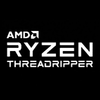Conclusion
We stated this in our 7980X review also, but we're really a bit surprised to see AMD launching new Threadripper processors for consumers and prosumers. The high-end desktop (HEDT) market, in my view, actually needs processors with up to 16 cores that offer faster performance, rather than the 32/64 core versions which tend to be slower. Combine this with the exorbitant cost of these CPUs and their significant energy consumption (350W TDP), and it's quite baffling. So, unless you're working in 3D creation or have specific workflows that benefit from a high core count, it's questionable whether these will succeed in the consumer market. Nevertheless, this doesn't make the Threadripper 7000 any less impressive, as the performance values we're seeing are quite remarkable. While single-threaded performance is decent, the real advantage becomes apparent with software applications that utilize all 128 threads.
Multi-Core Processors for High-Performance Computing
The recent advancements in processor technology have yielded new CPUs that demonstrate stable operation and manageable thermal design power (TDP) even under heavy loads. Notably, the 32-core variant maintains power consumption levels equivalent to those of the 64-core model, albeit with a lower base frequency. The processors exhibit substantial performance increases during multi-threaded tasks, assuming the software in use is optimized for multi-threading. These high-core-count processors, Threadrippers, are also capable of handling gaming applications, although their primary design is not centred around gaming performance. The cost-benefit ratio of these processors for gaming alone is not favourable. Instead, they are intended for intensive computational tasks that benefit from multi-threading capabilities, such as video editing and development environments say utilizing multiple virtual containers. For consumers with a focus on gaming, processors like the Ryzen 7000 series X3D with 6 or 8 cores are recommended as they provide sufficient performance at a lower cost. The Threadripper series, on the other hand, is tailored for a demographic requiring high-performance CPUs for tasks such as content creation, virtualization, animation, video editing, modelling, and ray-traced rendering. Historically, processors with core counts such as 6, 8, 12, 16, 24, 32, and 64 have been restricted to the high-cost server market, primarily dominated by Intel. However, these new CPUs have introduced a shift in this paradigm, offering these high-core-count processors at more accessible price points to a wider range of consumers. Benchmark assessments indicate that a lot of applications are limited to utilizing 16 or 32 threads, others effectively harness additional threads to deliver significantly improved performance outcomes. The architecture, which comprises eight 8-core dies alongside an I/O die, introduces complexities in terms of efficiency, scaling, and latency, which are inherent challenges in designing processors with such a high number of cores.
Application Performance
If the software application supports 48 or 64 threads, nothing is stopping this processor from ripping threads and spitting out serious numbers that will make your eyebrows frown, and then some. The base clock is superb and Threadripper parts years ago had the base clock at 3.0 GHz, that's now 4.0 GHz , on all cores. Add to that a 5.3 GHz boost and yeah, what can compare really? Never ever has my testing been this fast, I mean threaded software like VRAY and Cinebench takes mere seconds to finish, it's just wonderful and a little daunting to see, I admit.
The processor is composed of eight 8-core dies, known as chiplets, along with an I/O die. Such a complex design can encounter latency and scalability challenges. Doubling the core count from say 16 to 32 to 64 will not necessarily double performance exponentially, but significant gains can still be expected if the software is optimized for it. Latency issues are mitigated by large on-die caches and the swift PCIe 5.0 interfaces. AMD has applied a hefty 350 Watt TDP across its 24, 32, and 64-core processors, which is significant given the varying number of CPU dies; the 32-core model has four active, while the 64-core has eight active. However, scaling efficiency isn't linear, as evidenced by reduced base clock speeds to accommodate the same TDP. For instance, under full load, the 32-core 7970X runs at 4.0 GHz and a 5.3 Ghz Turbo, whereas the 64-core 7980X operates at a base clock of 3.2 GHz with a 5.1 Ghz Turbo for a few cores. This 800 MHz base clock difference per core is substantial when multiplied across all 64 cores, explaining the scaling dynamic. When fewer threads are active, turbo speeds of up to 5.1 GHz can be reached. Observing the many core performances is truly remarkable.
Gaming performance
Game performance is generally satisfactory. Do be aware that some games may not launch when confronted with 32 or 64 cores, as the software may not be equipped to handle such a high thread count. Overall though all tested titles at the very least worked. Obviously this platform has nothing to do with gaming, but if you want to, you can. While 3DMark showed very odd results the actually games perform well, not super great bit more in that mainstream segment of CPUs. I mean If you spend $2,499 (32-cores) or $4999 on a 64-core processor solely for gaming, it's not the wisest investment. However, the scenario changes if your primary concern is managing complex tasks with the occasional gaming on the side. Most games, however, run well and match the performance levels of your average Ryzen 7000 processor. There might be instances where a game cannot fully utilize the processor's capabilities though While sheer gaming performance isn't the primary reason to purchase such a high-core-count processor, the frame rates achieved are still fairly high.
DDR5 Memory
When considering a transition to an entirely new platform, the total cost of ownership is a significant factor. Even though the price of DDR5 memory is projected to decrease in the upcoming year, current market rates reflect a premium. For both Intel and AMD, a 6000 MHz configuration might offer optimal performance. In terms of stability, tests with a ~6000 MHz kit indicated consistent and reliable results. And considering what 4x16GB DDR5 costs these days, it's highly recommended.
Energy efficiency
The Threadripper 7000 series processors, with a TDP rating of 350W, deliver substantial performance but are energy-intensive. At idle, power consumption hovers around 150W, and under full load with all 64 cores active, this figure escalates by an additional 350W, resulting in a total power draw of approximately 500W. The duration of specific power states, which can be prolonged or shortened, depends on the motherboard BIOS settings. These extended power states not only increase energy consumption but also generate more heat. Nonetheless, cooling this processor presented no problems. Utilizing a 360mm Liquid Cooling System (LCS) from brands such as Corsair or NZXT, peak temperatures maintain around 90°C. Generally, operational temperatures tend to remain near 80°C. However, idle temperatures were somewhat elevated, often reaching the 40-50°C range.
We do want to mention that the high IDLE power consumption at roughly 150 Watts was a thorn in our eyes. We hope to see better values once a few BIOS updates have passed.
Tweaking
We had massive issues overclocking Threadripper 7000, not so much because of the processors' capability to do so (neither the motherboard) it's just that under normal load the system already pulled over 500 Watts, and overclocking resulted in immediate shutdowns of our Kilowatt PSU, that or a Thermal shutdown on the CPU. For the Threadripper 7980X we left things for what they were, for the 7970X however we've been able to hit 5200 MHz on all 32 cores... that yields this:
For the 7970X we retrieve ~ 32K points coming from 29K, say 10% extra performance.
Conclusion
As you greet the morning and find yourself standing beside the Threadripper 7970X/TRX50 PC, uttering 'your majesty' under your breath, it's clear that AMD has accomplished something noteworthy. Engaging with these processors instils a profound respect for their sheer capabilities prompting a mix of amusement and awe. Observing 64-threads in action and witnessing benchmarks complete in the blink of an eye is truly remarkable. It's challenging to find enough superlatives to describe this product. Nonetheless, the latest Threadripper CPUs cater to a niche audience within the consumer and prosumer markets. It's important to assess its intended user base. Aimed at the pro-consumer and small office/home office sectors, it remains a product for the few. AMD's release of the 32/64-core varianst may seem like a bold move against Intel, but there is a definite user base for it. Imagine encoding videos or rendering 3D content on all them cores—tasks that usually take a day could be reduced to mere hours, enhancing productivity significantly. Moreover, for virtualization, this processor is unparalleled. Take a 32-core processor with 256GB of RAM; you could set up 8 quad-core virtual private servers, each with 32GB of RAM. Power consumption then, our tests showed a system power under full load at approximately 500 Watts, which is very extreme. The Threadripper's TDP (Thermal Design Power) may seem high at 350 Watts, but in practice, it's more energy-efficient on a per-core basis. Regarding cooling, a 360mm liquid cooling system sufficed, keeping a fully stressed 32-core processor at around 80-90°C, which is impressive for such a high TDP many core processor. While Threadripper's most powerful processors may be relevant for only a small segment of the market, they have a substantial impact. Accompanying the new processors is the TRX50 chipset, designed to endure and support extensive PCIe Gen 5 bandwidth, ensuring that users won't lack throughput in the foreseeable future. For the average user, the allure of Threadripper might boil down to the prestige it carries, but for businesses requiring intensely multi-threaded environments, processors like the 7970X are invaluable. They deliver value for professional applications such as development and video processing, despite their premium cost. While 6 to 16 cores may suffice for most users, for those who need or aspire to have hyper-tasking capabilities and can harness the full potential of these processors in conjunction with the TRX50 platform, the 7970X/7980X models stand out as exceptional, albeit for a specialized audience. For the average user, a Threadripper will be overkill, but for businesses and prosumers with demanding, high-thread-count workloads, processors like the Ryzen Threadripper 7970X/7980X represent remarkable value. So what does twice the 7950X at $699 each cost? Well, you'd expect something in the $1500 range. However the 7970X at 2499 USD, well yeah, it's expensive. It does redefine value in the realm of high-core-count CPUs. Hence, it earns a top recommendation for its groundbreaking performance and innovation.
- Sign up to receive a notification when we publish a new article
- Or go back to Guru3D's front page.



